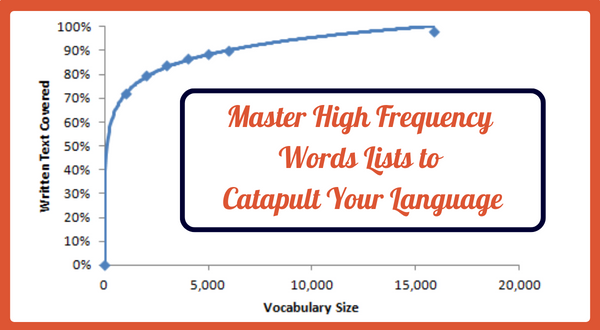In this expert-crafted guide, discover the art of prioritizing common words, the efficiency of a systematic approach, and the versatility of high frequency word lists.
From tailoring your learning experience to decoding the nuances of frequency dictionaries, explore the nuanced world of language acquisition. Uncover the truth about misconceptions, and learn how to wield high frequency words as powerful allies on your path to fluency.
Let’s delve into the intricacies of language learning, armed with the knowledge to build a robust vocabulary foundation and enhance your communication prowess.
What Are High Frequency Words?
High frequency words are commonly used words in a language that occur frequently in written and spoken communication.
These words are essential for effective communication as they form the backbone of everyday language use.
For example, in English, the top 1000 most common words account for over 80% of all written and spoken language.
Mastering high frequency words enhances language proficiency and facilitates smoother expression in both verbal and written communication.
What Are High Frequency Words Lists?
High frequency words lists are lists of the most common words in a particular language in order of usage.
Word frequency lists are available for many languages and can be found in various formats, including books, websites, and apps.
Some lists are general, while others are specific to certain topics or contexts, such as business or travel.
Research has shown that by using these lists effectively, you can quickly build a strong foundation of vocabulary, helping you communicate with greater ease and fluency.*
In this guide to using high frequency words lists for language learning, we’ll explore the benefits of these powerful tools, how to use them effectively, and some tips and tricks to take your language learning to the next level.
Whether you’re a beginner or an advanced learner, this guide provides you with knowledge and the resources necessary for success.
So let’s dive in and discover the power of the high frequency word list!
*All references cited at the end of the article
- What Are High Frequency Words?
- What Are High Frequency Words Lists?
- 1. Benefits of Using High Frequency Words Lists
- 2. High Frequency Word Lists vs Frequency Dictionaries
- 3. How to Choose the Right High Frequency Word List for Your Language Learning Goals
- 4. How to Effectively Use High Frequency Words Lists in Your Language Learning Journey
- 5. The Best Sources of High Frequency Words: Lists, Dictionaries, Apps and More
- 6. Common misconceptions about Using High Frequency Words Lists
- 7. Conclusion
- 8. References
1. Benefits of Using High Frequency Words Lists
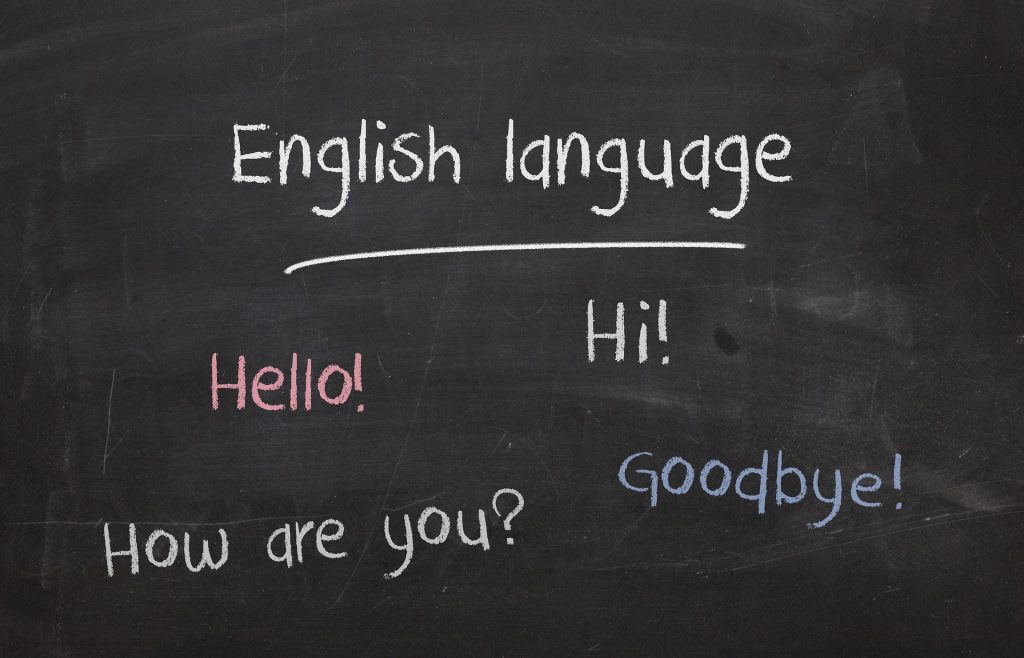
High frequency lists offer significant benefits in language learning by prioritising the most commonly used words.
Pay close attention to these high-frequency words.
They are the building blocks of a strong vocabulary, helping you understand what you read and express yourself better.
Not only that, but using these words will also give you a big confidence boost in your language skills.
You’ll feel much more self-assured and confident in your ability to communicate effectively.
Word frequency lists provide you with a targetted and practical approach. They help you focus on essential vocabulary for everyday communication.
This systematic learning method saves time and effort while giving you the vocabulary knowledge needed to navigate real-life language situations effectively.
A. Quickly build a strong foundation of vocabulary
High frequency words lists help you accelerate your vocabulary acquisition and build a solid foundation. Research has shown they help in the following ways.
A.1 Target Words You See Often
High frequency word lists allow you to focus on the most commonly used words in a language.
By prioritising high-frequency words, you efficiently build a foundational vocabulary that covers a significant portion of everyday communication (Nation, 2013).
By focusing on learning these words first, you can quickly move on to learn specific vocabulary that is used less frequently, but is relevant to your situation, which has been shown to speed language learning.
In any spoken or written text, you are likely to see these words repeatedly.
Many many high frequency words do not follow regular phonetic patterns, making them difficult to sound out using traditional phonics rules. In English we often call them ‘sight words’.
Sight words are commonly used words in the English language that language learners are encouraged to recognise and read instantly upon seeing them, without having to sound them out.
Examples of sight words include common words like “the,” “is,” “and,” “it,” “was,” “are,” and “you.” These short, frequently used words provide a foundation for reading fluency and comprehension.
A.2 Systematic Vocabulary Learning
Word frequency lists provide a structured and systematic approach to vocabulary acquisition.
You progress through the list in a logical order, ensuring coverage of essential words and avoiding random or haphazard vocabulary learning (Coxhead, 2000).
A.3 Expansion of Receptive Vocabulary
High frequency word lists expand your receptive vocabulary (the words you understand when you encounter them).
By focusing on the most commonly used words, you quickly develop a solid foundation of words you can comprehend (Meara, 2005).
A.4 Reinforcement through Exposure
Because you encounter common words repeatedly in authentic texts or conversations, studying frequency lists helps reinforce and solidify your understanding and retention of those words (Nation, 2013).

A.5 Building Word Families and Collocations
Word frequency lists can help you identify word families (related words with the same root) and collocations (words that commonly appear together).
By studying the most common words, you can develop a network of related words and phrases, enhancing your overall vocabulary knowledge (Nation, 2013).
B. Save time and effort
B.1 Efficient Vocabulary Selection
Word frequency lists provide a ready-made selection of the most common words used in a language.
Instead of spending time searching for vocabulary or relying on random word selection, you can focus on studying words that will have the greatest impact on your language proficiency (Nation, 2013).
B.2 Streamlined Learning Process
Word frequency lists offer a systematic approach to vocabulary acquisition. You avoid wasting time deciding which words to study or in what order (Coxhead, 2000).
B.3 Enhanced Language Comprehension
By prioritising the most common words, you can improve your reading and listening comprehension abilities.
Understanding these frequently used words enhances your overall language comprehension, making it easier to understand and process written and spoken texts. This in turn reduces the time and effort required for comprehension (Laufer & Nation, 1999).
B.4 Reinforcement through Exposure
You encounter high-frequency words repeatedly in authentic language materials, such as books, articles, or conversations.
By studying frequency lists, you reinforce and solidify your understanding and recognition of those words.
Repeated exposure to the words in various contexts in turn accelerates the learning process and reduces the effort needed to internalise them (Nation, 2013).
C. Provides motivation and confidence
Research tells us that high frequency words lists result in tangible progress, immediate applicability of your knowledge, enhanced communication skills, improved comprehension, reduced language anxiety, and a sense of mastery.
When you can see these things happening quickly, they contribute to increased confidence and motivation in your language learning.
Confidence, in turn, has been shown to be a key factor in accelerated language learning (Coxhead, 2000; Laufer & Nation, 1999; MacIntyre, P. D., & Charos, C., 1996; Nation, 2013).

2. High Frequency Word Lists vs Frequency Dictionaries
When it comes to word frequency resources, there are word frequency lists and frequency dictionaries.
Word frequency lists provide a straightforward overview of the most commonly used words, while frequency dictionaries offer comprehensive information and contextual understanding.
Let’s explore the features, pros, and cons of both, providing insights to help you to make an informed decision on which resource best suits your language learning needs.
WORD FREQUENCY LISTS
PROS:
- Provide a comprehensive overview of the most frequently used words.
- Simple and easy to use, making them accessible to learners of all levels.
- Can be customized to suit individual learning preferences.
CONS:
- Lack detailed context and examples, making it harder for learners to grasp word usage nuances.
- May not include additional language insights and cultural information.
FREQUENCY DICTIONARIES
PROS:
- Offer detailed word entries, providing learners with comprehensive information.
- Present semantic relationships and usage examples, aiding in a deeper understanding of words.
- Include cultural and linguistic insights, enriching learners’ language skills.Provide a comprehensive overview of the most frequently used words.
CONS:
- Lack detailed context and examples, making it harder for learners to grasp word usage nuances.
- May not include additional language insights and cultural information.
A. Features of High Frequency Word Lists
Word frequency lists offer a straightforward approach to language learning, providing you with a ranked list of words based on their frequency of occurrence in a given language.
A.1 Simplicity and ease of use
Word frequency lists are usually just that: a list of words, from most frequent to less frequent. This means they are simple to use, even for beginners. They provide a quick reference for you to identify and focus on the most frequently used words.
A.2 Flexibility
High frequency words lists can be adapted to suit individual learning needs. You can often find lists (or create them) to prioritise specific word categories.
Alternatively, you can find themed lists, customising your learning to your areas of interest, which is known to enhance your language learning experience.
B. Features of Frequency Dictionaries
While word frequency lists have their advantages, frequency dictionaries offer distinct benefits that might appeal to certain language learners.
Frequency dictionaries go beyond simple word lists, giving you additional information and context for each word. Here are some key features that set frequency dictionaries apart:
B.1 Detailed word entries
Frequency dictionaries typically include comprehensive word entries, offering information about the word’s part of speech, pronunciation, definitions, and example sentences.
This additional context helps you understand the word’s usage in different contexts. It also helps you learn grammar while learning the vocab.
B.2 Semantic relationships
Frequency dictionaries often include information about the semantic relationships between words, such as synonyms, antonyms, and related terms.
This feature gives you an opportunity to deepen your understanding of word meanings and expand your vocabulary effectively.
B.3 Language insights
Frequency dictionaries often include cultural and linguistic insights, such as valuable information about idiomatic expressions, collocations, and usage patterns.
Such insights improve your grasp of the language and aid in your fluency development.
In summary, both word frequency lists and frequency dictionaries have their strengths and weaknesses.
Depending on individual learning preferences and goals, your should choose the resource that best aligns with your needs.
3. How to Choose the Right High Frequency Word List for Your Language Learning Goals
Choosing the right high frequency word list is important for achieving your language learning goals. Here are some factors to consider when selecting a list.
A. Language Level
High frequency words lists are available for different language levels, from beginner to advanced. Make sure to choose a list that is appropriate for your level of proficiency in the language.
To start with, do a general search like “top 1000 most common words in Spanish”.
Once you have developed a reasonable language base, you can try looking for word lists of a specific aspect of the language, like “top 100 most common French adjectives”, or “top 100 most common verbs in Korean”.
B. Language Variety
Some high frequency words lists are specific to certain varieties of a language, such as American English or British English. Make sure to choose a list that is appropriate for the language variety you are studying.
C. Topic or Context
Some high frequency words lists are specific to certain topics or contexts, such as business or travel. If you have a specific language learning goal, such as preparing for a business trip, choose a list that is tailored to that goal.
D. Format
High frequency words lists are available in various formats, including books, websites, apps and pdfs. Choose a format that is convenient and accessible for you.
4. How to Effectively Use High Frequency Words Lists in Your Language Learning Journey
Using high frequency words lists effectively in your language learning journey involves more than just memorising words. Here are some tips for using word frequency lists effectively.
A. Use Context to Aid Understanding
When learning new words, try to understand them in context. If you can’t write your own sentence or sentences with the word in use, find an example of the word used in a sentence.
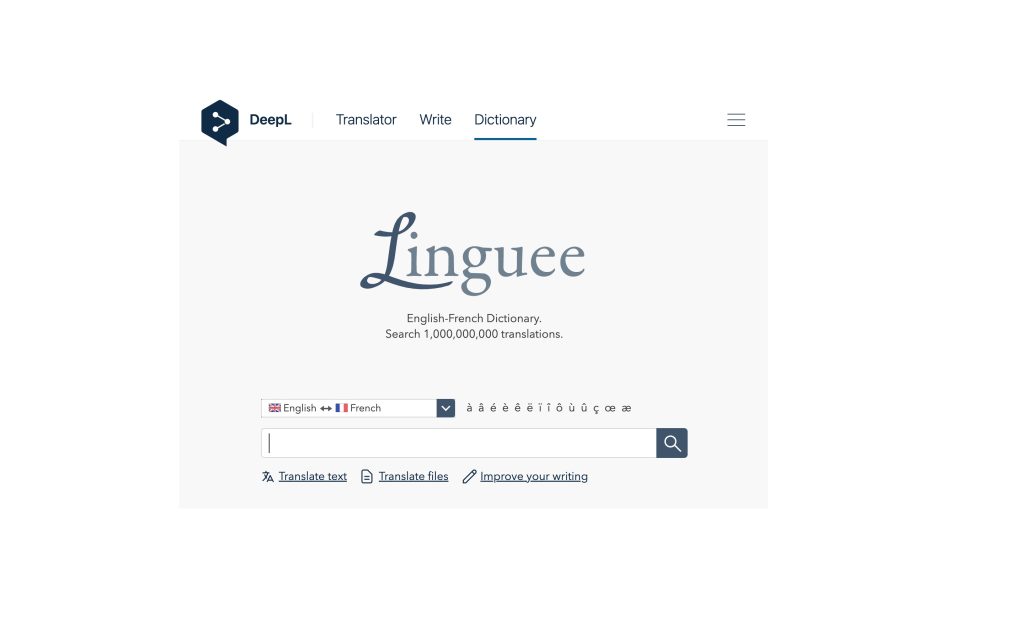
Linguee is a particularly useful tool to help with finding sentences in many (predominantly European) languages.
Alternatively create one with AI tools (but check that it is a good example!).
Learning the vocabulary in sentences as much as possible will help you remember them better and use them more effectively in your own communication. It has the advantage of exposing you to the grammatical use of the word as well.
B. Use Flashcards or Spaced Repetition Software
Flashcards or spaced repetition software can be effective tools for learning new words. These tools allow you to review words at intervals that are optimised for retention. Check the apps listed below for some suggestions.
C. Keep a Language Learning Journal
Keeping a language learning journal can help you track your progress and identify areas for improvement. Write down new words and phrases you learn, and practice using them in context.

5. The Best Sources of High Frequency Words: Lists, Dictionaries, Apps and More
A. High Frequency Words Lists
You can find high frequency word lists online very easily for most languages. Wiktionary.com has links to almost 100 high frequency words lists for languages from Adnyamathanha to Yiddish, as well as many links to word lists on other sites.
B. Word Frequency Dictionaries
Routledge and many other publishers produce word frequency dictionaries. They list each word, numbered in order of frequency, with part of speech, a translation and often example sentences.
This photo inside the Routledge Word Frequency Dictionary for Korean also shows a themed panel with common words associated with the concept of ‘Leisure’.
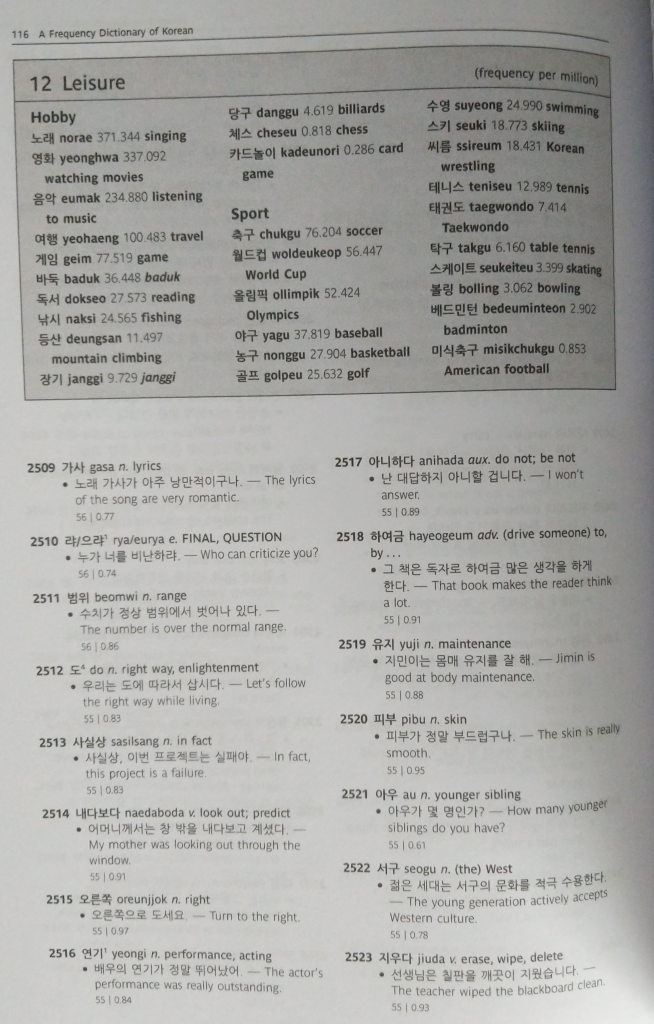
C. High Frequency Words Lists in Apps
There are two apps, both free, that I recommend for learning with high frequency words lists.
If you have reasonable tech-ability, Anki is a popular flashcard app using spaced repetition software. It allows you to create your own high frequency words lists.
It is also possible to find and import decks that others have created. Simply search for “anki decks” + “top words in [your target language]”.
If you can’t be bothered with getting technical, the crowd-sourced aspect of Memrise really helps here too, with many courses of high frequency words lists contributed by the community. After enrolling in a course on the website, you can use the app on your phone, or use the website to learn.

Fluent Forever has a paid app that has been built on a combination of 625 high frequency and most useful words, according to Gabriel Wyner (the product’s designer). It is based on a method he has developed for himself as he learned languages. The app is available for the following languages:
- Castilian Spanish
- Spanish LA
- French
- German
- Japanese
- Italian
- Mandarin
- Russian
- Korean
- Dutch
- Portuguese
D. Using ChatGPT to Generate High Frequency Words Lists
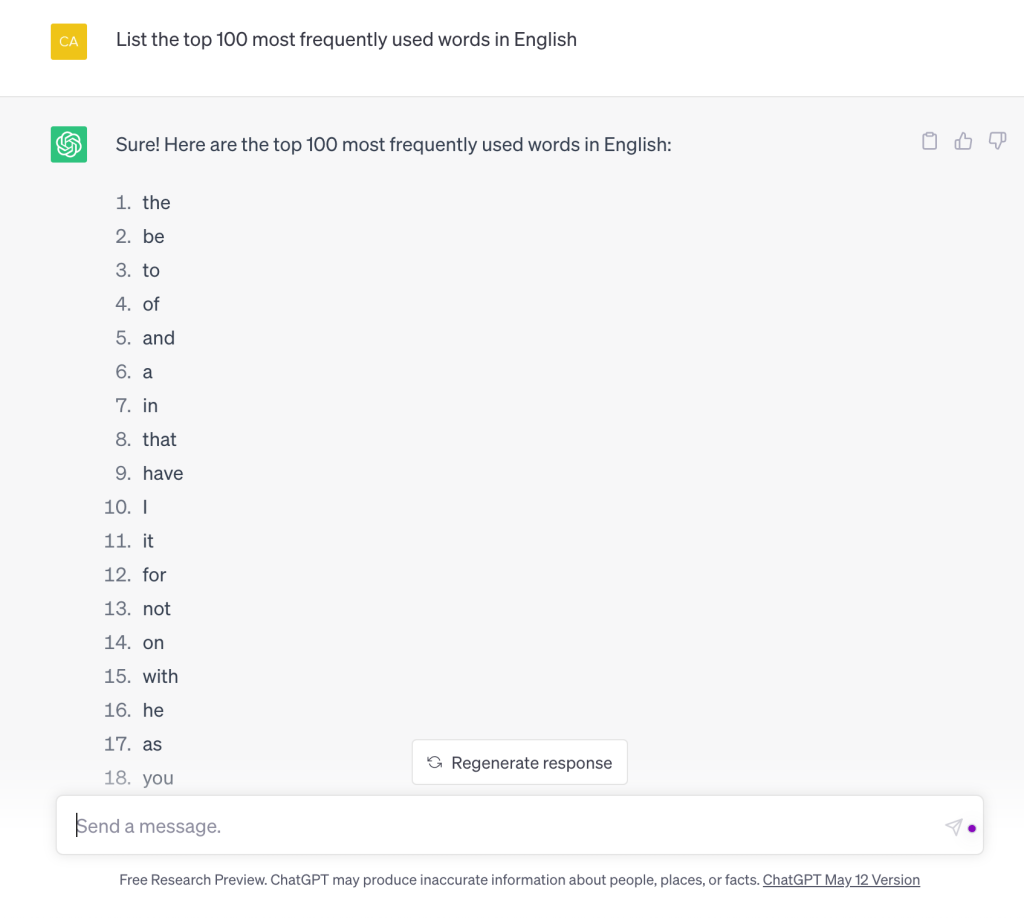
of the most common words in your target language.
ChatGPT can be a very useful resource for generating specific words lists. Consider using prompts like the following to get the most helpful results:
- You are a French language education resource. List the top 100 most commonly used French words. Show gender cases of nouns by including an indefinite article ‘une’ for feminin and ‘un’ for masculin. Example: un chemin; une heure.
- List the top 10 Arabic nouns in the theme of ‘houses’.
- List the top 10 Spanish words around the theme of ‘cycling’.
- List the top 10 most commonly used Japanese adjectives to do with weather.
The jury is still out on how accurate the results are likely to be with the current version of ChatGPT, however it is unlikely to go too far wrong with something this simple. Nevertheless: always Trust, but Verify!
6. Common misconceptions about Using High Frequency Words Lists
There are some common misconceptions about using high frequency words lists in language learning. Here are a few of them:
A. Misconception #1: High frequency words lists are boring
While studying vocabulary may not be the most exciting part of language learning, high frequency words lists can actually be quite motivating. By focusing on the most common words in a language, you can quickly start communicating with greater ease and fluency.
B. Misconception #2: High frequency words lists are all you need to learn a language
While high frequency words lists are a powerful tool for language learning, they are not the only tool you need. To truly master a language, you need to practice using it in real-life situations, such as conversation with native speakers or reading authentic materials.
C. Misconception #3: Learning vocabulary is all you need to communicate effectively
While having a strong vocabulary is essential for effective communication, it’s not the only factor. You also need to understand grammar and sentence structure, as well as cultural differences and nuances in language use. High frequency word lists are a great tool in your arsenal of language learning resources, but make sure you supplement them with other sources of information to round out your learning.
7. Conclusion
Language learners benefit greatly from high frequency words lists as they provide a powerful means to concentrate on the most significant words and phrases of a language.
Utilising these lists proficiently can enable learners to establish a robust base of vocabulary and grammar, thereby facilitating improved communication with greater fluency and ease.
While high frequency words lists are not the only tool you need for language learning, they are a valuable resource that can help you achieve your language learning goals. So don’t hesitate to incorporate them into your language learning journey and see the results for yourself!
8. References
- Coxhead, A. (2000). A New Academic Word List. TESOL Quarterly, 34(2), 213-238.
- Laufer, B., & Nation, I.S.P. (1999). A Vocabulary-size Test of Controlled Productive Ability. Language Testing, 16(1), 33-51.
- MacIntyre, P. D., & Charos, C. (1996). Personality, attitudes, and affect as predictors of second language communication. Journal of Language and Social Psychology, 15(1), 3-26.
- Meara, P. (2005). How Large Can a Receptive Vocabulary Be? Applied Linguistics, 26(3), 341-358.
- Nation, I.S.P. (2013). Learning Vocabulary in Another Language. Cambridge University Press.
Cate is a language enthusiast sharing her language learning journey here. Apart from her native English (albeit 'Strine'*!), as an adult she has also learned Auslan (Australian Sign Language) to approximately a C1 level, Dutch to around B1/2, French to around A2, and has a smattering of other languages.
B.A. (Anthropology/Marketing), Grad. Dip. Arts (Linguistics), Grad. Cert. Entrepreneurship & Venture Development, (CELTA).
Auslan Interpreter (NAATI), and general Language Nut.
*For more information on 'Strine', visit https://en.wikipedia.org/wiki/Strine

